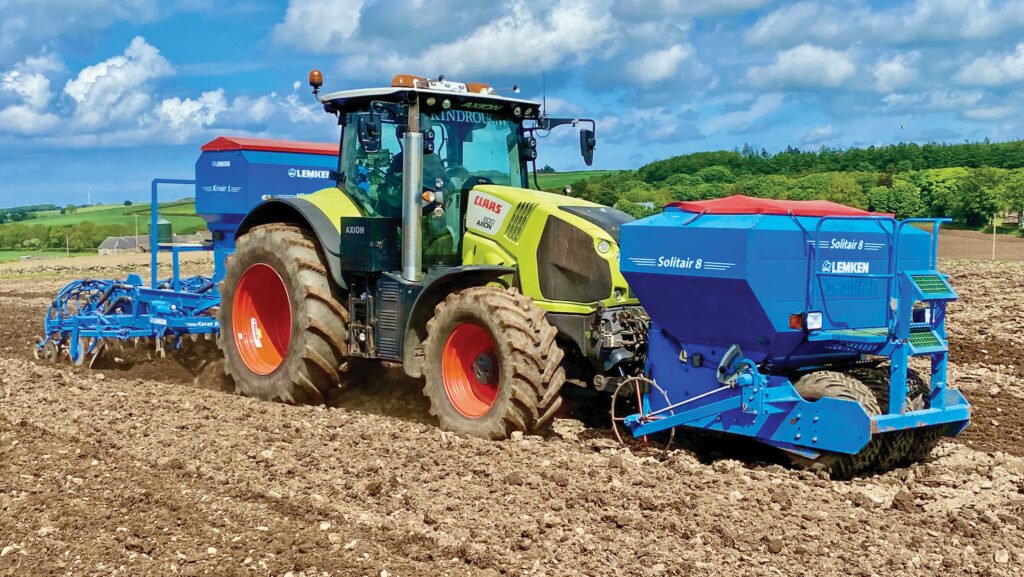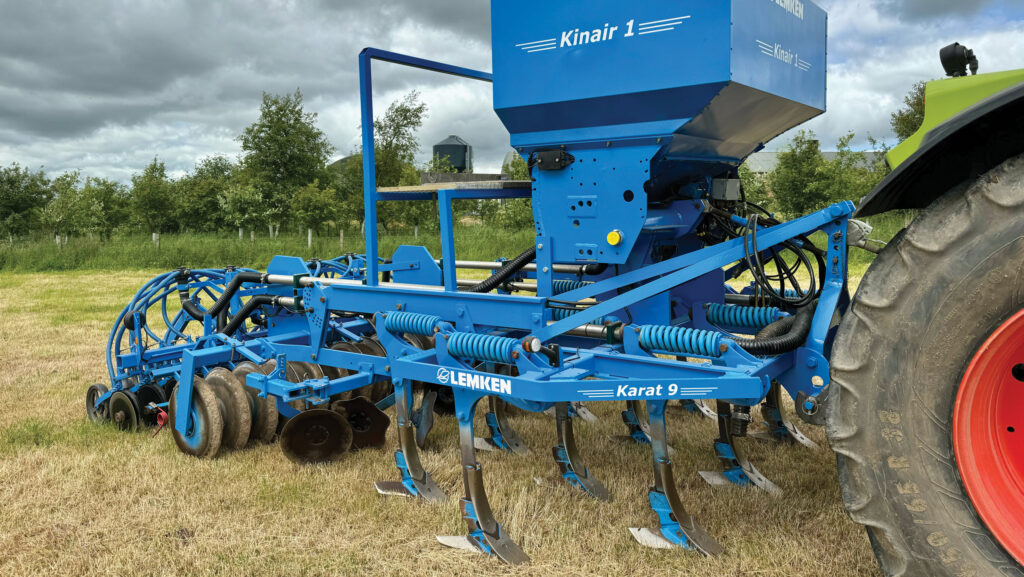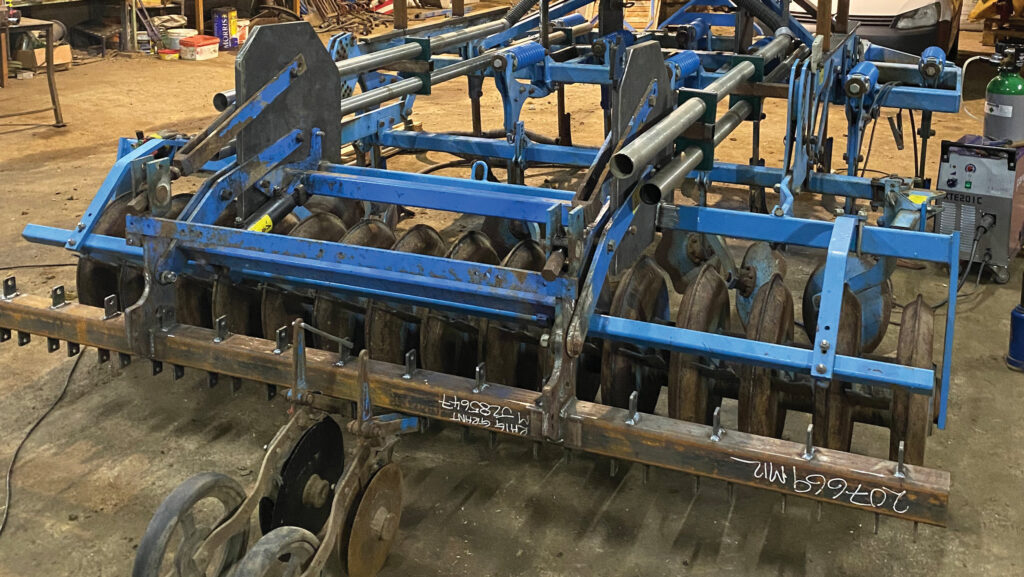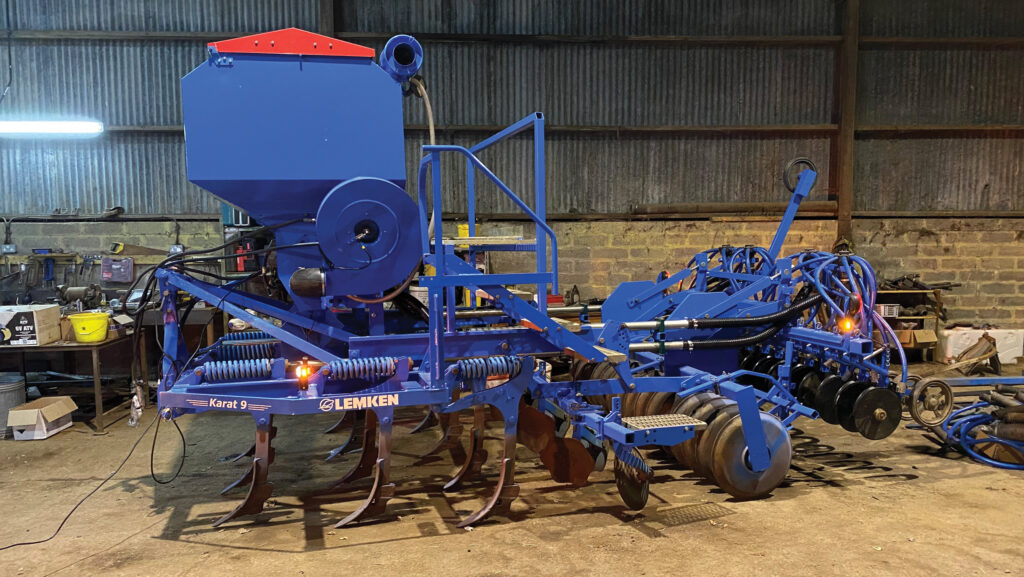Farmer combines Karat and Solitair for one-pass bean drill
 © Brian Penny
© Brian Penny It’s a Lemken drill, but not as you know it.
The perfectly colour-matched Kinair, named after Craig and Claire Grant’s Kindrought Farm and the Solitair seeder on which it is based, is a marriage of two of the German firm’s most popular implements.
It spawned from an efficiency drive at the Grants’s Aberdeenshire business, in part following a surge in the price of soya that had been the sole source of ration protein for their flock of 160,000 hens.
See also: Home-built overseeder improves grass in hard-to-reach fields
Farm facts: Kindrought Farm, Portsoy, Aberdeenshire
- Area 440ha, including 283ha of combinable crops
- Stock 300 cattle, 380 ewes with 646 lambs, 1,500 store lambs and 160,000 laying hens
- Target arable rotation Six years – winter barley, rapeseed, wheat, beans, wheat and spring barley
Soya cost
The birds were pecking through some 29t of South America’s finest every week, and the price of this came under intense scrutiny during a three-year stint in Leaf’s Resilient and Ready programme.
“It focused on efficiency and sustainability, so we had to explain and quantify every decision we made,” says Craig.
“How could we justify paying £600/t for imported soya [up from £330-£350] when beans – albeit with half the protein content – were trading at £250?
“Not only could we afford to buy them, but we could, in theory, grow them as profitably as wheat.”
Though it was a potentially viable option, producing beans at such a northerly latitude is exceptionally rare and not without risk.
Switch to beans
The Grants decided to take a punt and drilled 4ha of spring beans in 2021, which yielded 22t – enough to conduct a trial in one 12,000-bird shed.
“Unexpectedly, the hens did better on the bean diet and our bottom line improved.
“That was always the priority, but it was interesting to find that being greener and reducing our carbon footprint was more efficient for the business.”
Though the concept was semi-proven in that first year, spring sowing was scrapped in favour of autumn establishment, largely because of the earlier harvest that follows. This crop also tends to yield slightly better.
Scotland’s very own “Mr Bean” is now encouraging other local farms to get in on the act, with his hens providing a ready-made market.
“We’ve cut our soya consumption by 50% and will continue to make adjustments in a measured way that isn’t detrimental to the birds,” says Craig.
“We’re currently using 23t of beans a week, but only 40% of that is grown around here – 32ha on our farm, and 40ha by two neighbours.
“That means we’re having to haul around 650t/year up from southern Scotland, which is costly and unnecessary.”

© MAG/Oliver Mark
Drilling rethink
To start with, Craig established the crop in conventional fashion – plough, power harrow, drill 100mm deep, then finish with a Cambridge roller.
However, this was diesel hungry, invariably ran late into the season, and left the ground vulnerable to nasty weather part way through.
“I was always frightened of a spell of rain or snow,” says Craig.
“If it came after ploughing, then we’d be unable to travel, and battering the soil to a fine tilth with the power harrow destroyed the structure and left it susceptible to erosion.
“We weren’t even in the clear post-rolling, as any rain tended to seal surface and make it hard for crops to emerge.”
But by changing his drill, he could potentially work straight into stubbles, doing away with any prior cultivations and leaving a more open, cloddy finish that would improve drainage.
Inspiration for his build came from an earlier purchase of a seven-year-old Karat 9 stubble cultivator, with its combination of ripping/mixing legs and heavy double-D press.
Using it ahead of the Solitair drill when sowing oilseed rape had demonstrated its effectiveness in loosening the ground and incorporating trash, while maintaining deeper soil structure and leaving a firmer surface than a plough.
“I wanted to make the drill versatile enough to sow catch and cover crops, beans, oilseed rape and bird cover – basically something similar to a Simba X-Press conversion, but with a big hopper,” he says.
“That would allow me to spread the cost of building it over more acres, and it could also act as a second drill to help with wheat and barley at the back-end of the season.”
Karat revamp
The easiest part of the Karat conversion was swapping the relatively narrow points on its 11 auto-reset legs for 120mm-wide versions.
These are now flanked by wings that cover a 300mm width to cut, lift and boil the topsoil and mix in muck and straw.
When drilling oilseed rape, they are set to run just 80mm deep; for pulses, they’re plunged to double that.
“Getting the beans deep enough is essential, otherwise the roots can just push the seeds out and leave them vulnerable to frost and birds,” says Craig.
With plans to mount a hopper on top and hang a coulter bar off the back, adding roughly 1t in metal and another 1t of seed – and taking total length to that of a five-furrow plough – the Karat also needed beefing up.
So he strengthened the headstock and bolted on four chunky lengths of steel bar to brace it from the top link to the centre and back of the main frame, eliminating any risk of flex that would affect drilling accuracy.
The final modification still left to do is to fit side skirts alongside the outermost legs to limit soil throw beyond the working width.

© Brian Penny
Donor drill
The second stage of the build started with sourcing a donor Solitair drill. A candidate in a rough state of repair was duly found, and its power harrow sold to cover most of the cost.
Its 1t hopper was hoisted off, shot-blasted and painted, then mounted atop the Karat on laser cut brackets.
The metering unit and controls required little work, but all the bearings, bushes and oil pipes were replaced, and he fitted a set of access steps up the offside.
Seed from the tank is run through two stainless-steel pipes to the disc coulters, with another pair of pipes acting as the conduit for fertiliser from a second hopper mounted on the front of the tractor.
In the case of bean drilling, that’s 250kg/ha of a phosphorus and potassium compound to hasten root development.
On the back are the Solitair’s original row units, albeit fitted to a new coulter bar at 200mm centres that gives the crop more light and space than the standard 150mm setup would allow.
The coulters were treated to new discs and bearings, at a cost of £700, as well as new single springs to ensure they bite into the ground.
Fortunately, the existing depth wheels that trail them were in perfectly serviceable condition, as were the four distribution heads, avoiding the need to spend further cash.
When sowing rapeseed, a set of Lemken angled tines are mounted behind the Karat’s double-D packer to tickle tilth into the channels it leaves, ensuring the seeds aren’t sown too deep.
For beans, those tines are moved to mounting points on the rear coulter press wheels to allow for deeper drilling and to provide some extra consolidation.
Depth and pitch adjustments of the coulter bar are much like a standard Solitair, and Craig has also fitted a sensor on the frame that shuts the seed flow as the drill lifts and the packer subsequently drops.
The only impending change following its spring trial run is to the metering wheel.
The rubber-wrapped original proved too small and prone to bouncing over cloddy surfaces, so it’ll be swapped for a big, metal version with spokes that bite into the ground more reliably.
All in, the project cost £15,000, including the cost of the Karat and donor Solitair, plus all-new metal, bushes, bearings and a full lighting package.

© Brian Penny
Proven concept
The drill was finished in early spring, leaving a brief window to trial and fine-tune it ready for the autumn campaign.
That work was done sowing vetch in a field thick with trash following a straw-covered carrot crop.
“There was 10ha’s worth of straw for every 1ha of ground, and it got both hen muck and lime,” says Craig. “We had to plough it first, but the drill still did a great job.”
In future, doing away with the plough in a single-pass drilling system, at least for part of the rotation, will rely on keeping crops clean to avoid perpetual weed problems.
But, he says, that challenge is far outweighed by the benefits.
“We can still cover over 20ha a day at 8-10kph, and using the Kinair rather than a power harrow combination to drill the beans should save us about 3 litres/ha of diesel. Plus, we can knock the £75/ha cost of ploughing out of the equation.”
The plan for the coming season is to sow 25ha of green cover – a mix of crimson clover, phacelia, and winter rye – to add organic matter and perk up ex-potato land that took a battering over winter.
There will also be 40ha each of oilseed rape and beans to put in – plus any extra that comes Craig’s way from neighbouring farms.
“I’m not an expert at growing beans – I’m learning as I go,” he says. “I just want to make the business more efficient, and beans are definitely part of that.”

